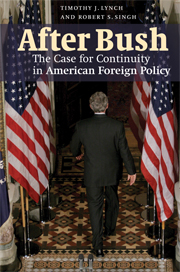Book contents
- Frontmatter
- Contents
- List of figures
- Acknowledgements
- Introduction: Winning the Second Cold War
- Chapter 1 Bush and the American foreign policy tradition
- Chapter 2 The constitution of American national security
- Chapter 3 The Second Cold War on Islamist terror: negative audits
- Chapter 4 The Second Cold War on Islamist terror: a positive audit
- Chapter 5 Iraq: Vietnam in the sand?
- Chapter 6 The Middle East: reformation or Armageddon
- Chapter 7 Frineds and foes after Bush
- Chapter 8 The emerging consensus at home and aborad
- Conclusion: The case for contiuity
- Notes
- Bibliography
- Index
Conclusion: The case for contiuity
Published online by Cambridge University Press: 22 September 2009
- Frontmatter
- Contents
- List of figures
- Acknowledgements
- Introduction: Winning the Second Cold War
- Chapter 1 Bush and the American foreign policy tradition
- Chapter 2 The constitution of American national security
- Chapter 3 The Second Cold War on Islamist terror: negative audits
- Chapter 4 The Second Cold War on Islamist terror: a positive audit
- Chapter 5 Iraq: Vietnam in the sand?
- Chapter 6 The Middle East: reformation or Armageddon
- Chapter 7 Frineds and foes after Bush
- Chapter 8 The emerging consensus at home and aborad
- Conclusion: The case for contiuity
- Notes
- Bibliography
- Index
Summary
PRESIDENT: I know there is much we can learn from each other if we can negotiate a truce. We can find a way to coexist. Can there be peace between us?
ALIEN: Peace? No peace.
PRESIDENT: What do you want us to do?
ALIEN: Die.
Independence Day, directed by Roland Emmerich (1996)By early in Bill Clinton's first term the cabal was in place. Tony Lake, conscientious objector to Henry Kissinger, was the new national security assistant. His deputy, Samuel Berger, was a foreign policy liberal and multilateralist – later found guilty of stealing classified national security documents. Number three on the new NSC staff was Nancy Soderberg, a young female acolyte of Senator Ted Kennedy, a liberal relativist of impeccable credentials. At Foggy Bottom was Warren Christopher, a secretary of state whose previous White House service had been in the vacillating Carter administration, 1977–81. Several other ex-Carter people reappeared in the new Democratic administration. Within weeks of their residency in Washington these men and women were calling for and were on the way to implementing a foreign policy of democratic enlargement, engagement, humanitarian assistance, and international social work.
There was, in short, a liberal conspiracy at the heart of the Clinton administration. This domestically focused president – a man whose most effective campaign slogan was ‘It's the economy, stupid!’ – was victim to a liberal cabal who made foreign policy in its image.
- Type
- Chapter
- Information
- After BushThe Case for Continuity in American Foreign Policy, pp. 289 - 298Publisher: Cambridge University PressPrint publication year: 2008



